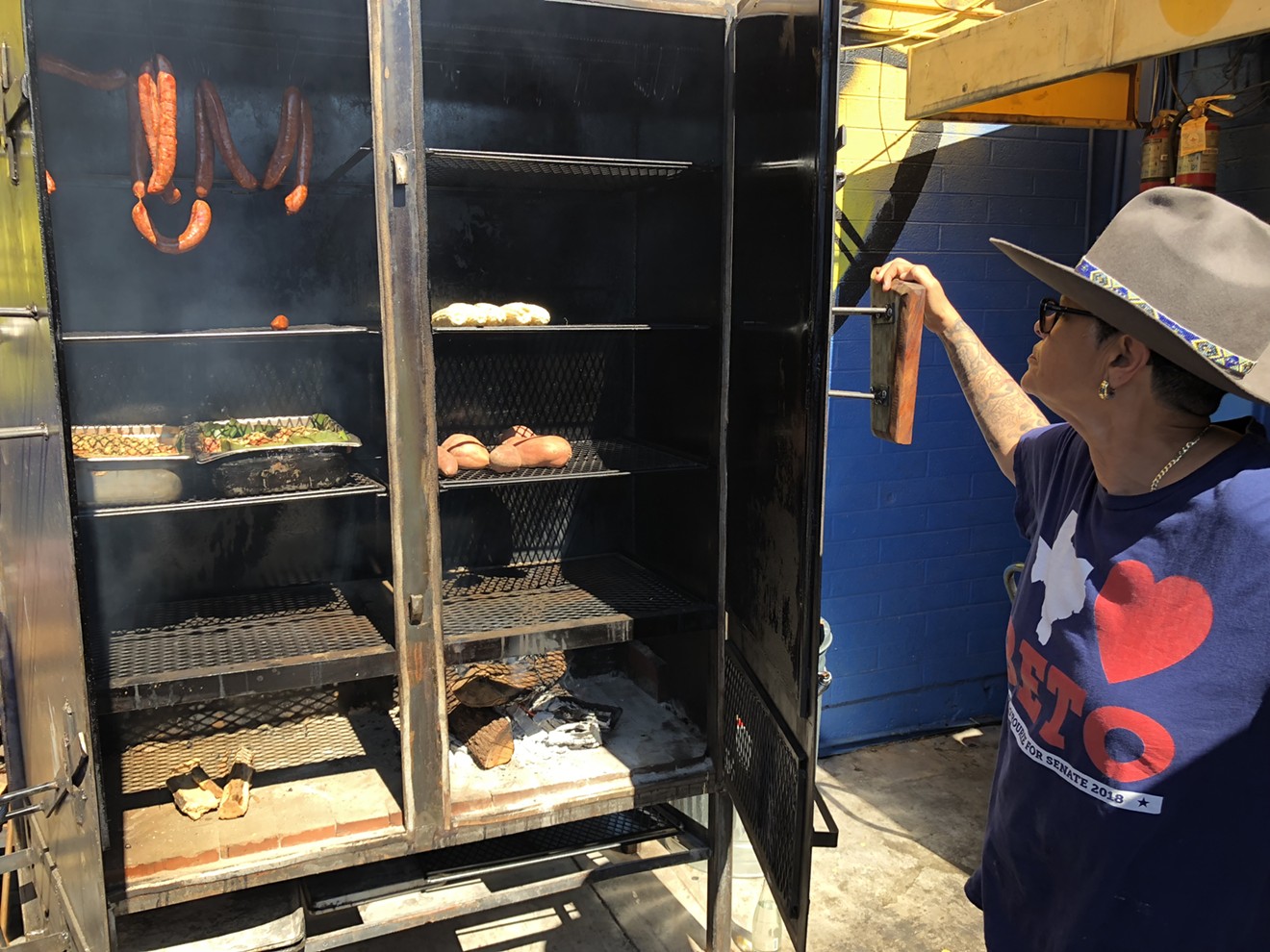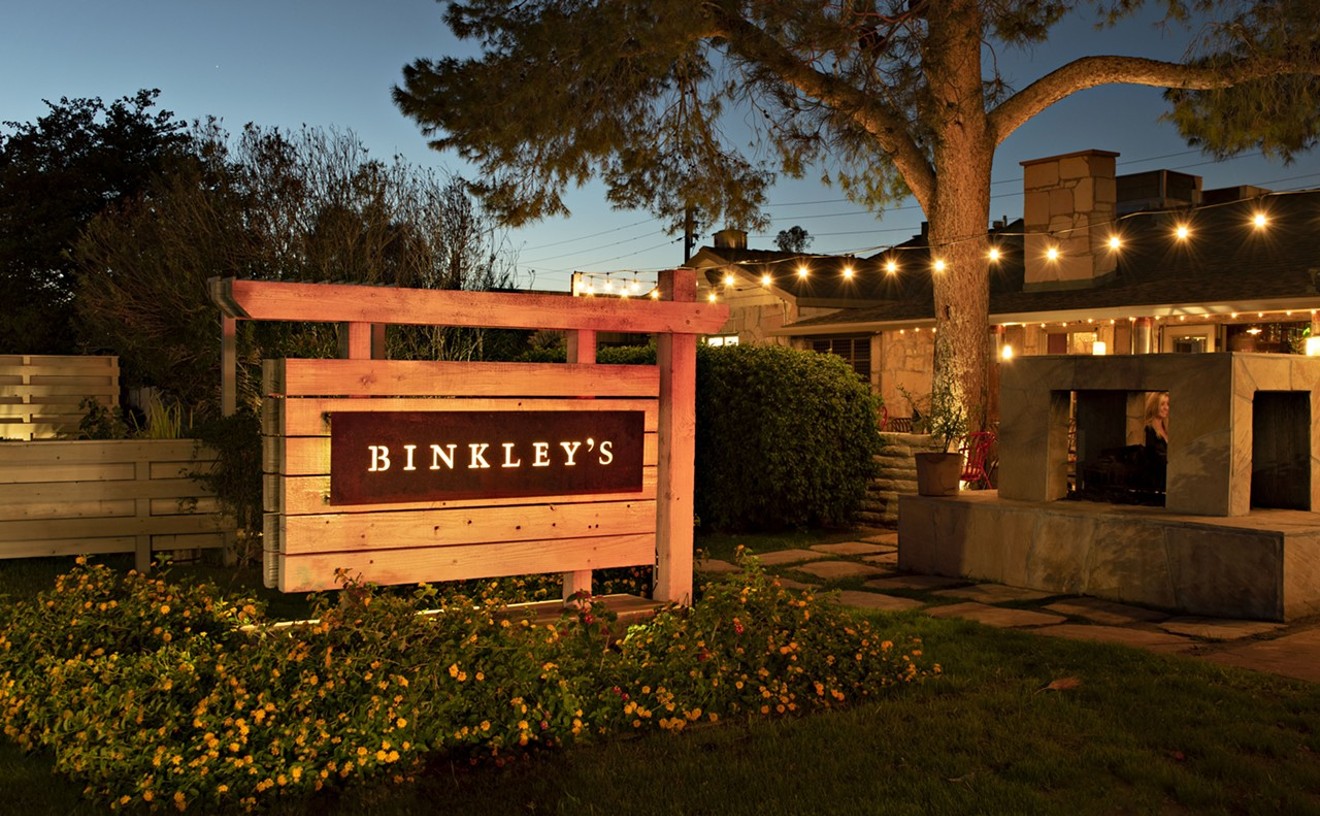Barrio Cafe’s parking lot has a new addition that teases your senses from the second you open your car door. It floors you the same way the street art floors you swirling across the walls in pyrotechnic curves and colors. It floors you through smell. Pecan smoke. Fumes from red and post oak. One whiff and your heart backflips.
Silvana Salcido Esparza, the pioneering chef at Barrio Cafe, is trailblazing again. She recently had a smoker custom-made for use at Barrio Cafe. A year ago, the first time we reported on Silvana’s dreams of barbecue, she was testing recipes for a barbecue joint she wanted to open in the distant future. Following a three-month journey to barbecue stands and shacks from California to Carolina, the future has clarified, the dream become more concrete.
The smoker at Barrio Cafe is shaped like a giant locker. It has two doors, many racks, black paint, “chorizo hooks,” and a handle that can be turned to cinch the top opening of the smokestack, editing the smoker’s pull.
Right now, Esparza is smoking a few things inside. Chorizo. Cochinita pibil. Yams to be mashed into mole and side dishes at Barrio Cafe Gran Reserva. She has been experimenting with this and that, maybe tamales, maybe al pastor pork chops with smoked pineapple.
William Hemphill built the upright smoker for Esparza. She was inspired by an upright she saw at a roadside spot in Santa Maria, California. Esparza loads split wood into the smoker’s bottom. As it burns, fragrant smoke rises through the box, heating the roomy locker to somewhere in the range of 250 degrees.
These days, upright smokers are as out as disco. The latest wave of barbecue wonks prefers Texas-style offsets, which create a dryer atmosphere and pull smoke through long steel chambers.
“If you look at that box, unlike an offset smoker, it’s kind of close to a pit,” Esparza says. “The smoke stays in the box, where with the other one the smoke is billowing through and drawing."
For Esparza and her barbecue dreams, similarity to a pit is crucial.
Cochinita pibil, Esparza’s signature dish, is a meal that has been cooked in pits since long before Cortez met Montezuma in the canals of Tenochtitlan, the Aztec capital city. The dish comes from farther south in Mexico, from land once home to the Mayans. Pibil, a Mayan word, refers to cooking in the ground. With her new upright, Esparza now has a smoker that, with the help of water pans and banana leaves and marinades, can simulate pit barbecue. This gives her cooking a nice new wrinkle.
Mexican barbecue is pit barbecue. The north and central regions of Mexico are known for pit barbecuing (true barbacoa). This process entails digging a hole in the ground, encasing large cuts or whole animals in seasonings and leaves, and letting meat cook in the covered earth for long periods of time, often overnight.
Esparza is hoping to capture the spirit of this ancient process even better with her next smoker: a raised box she plans to use for whole-hog barbecue.
“I’m training for a barbecue place,” she says. “You know, I wasn’t praying for a Mexican restaurant [before she opened Barrio Café], but I trained for one by backpacking through Mexico for almost a year. So I did the same full-hearted effort with barbecue that I did with Mexican.”
Her dreams of barbecue go beyond what she saw on her three-month, 13,000-mile, 17-state barbecue scouting trip. That said, what she saw will inform how she smokes meat.
She saw tri-tip steak raised high on Santa Maria grills and partly smoked, partly grilled. She saw a whole hog cooked in Arkansas using a cement pit and shoveled coals.
She saw a man in Texas who kept a mattress by his pit so that he, sleeping apart from his wife, his feet dangling near the fire, could better nurse the overnight flames.
Esparza even saw Mexican-tinged barbecue.
“Not Mexican like I’m thinking Mexican,” she says. “None of these people I talked to backpacked through Mexico like I did and has an extensive regional study of Mexican gastronomic treasures. They do the best with what they know.” What she saw was more Tex-Mex, more American barbecue with Mexican elements.
Esparza believes that barbecue came to America when the Chichimeca, the native people of northern Mexico, shared the secrets of pit barbecue with “the American cowboy.”
“The Chichimecas were all the way up to Utah,” she says. “And so they were doing that technique [pit barbecue], as well as in New Mexico.”
One of her favorite stops was in Albuquerque. A place called ABQ BBQ mixed a “Christmas-style” barbecue sauce with red and green chiles, just like the bicolor New Mexican blend.
“Look at their box, look at their wood, study their brisket,” went her summer-long motto.
Now, at Barrio Café, Esparza is using wisdom from the road. She is experimenting, honing a progressive American-Mexican style that fits a chef who serves bread and olive tapenade — and not chips and salsa — to open meals at her landmark Mexican restaurant.
Her barbecue techniques are refining.
An order of cochinita pibil at Barrio Café brings pork heaped in a pool of bright orange sauce. The texture approaches pulled pork, and the inner pieces, as with pulled pork, have only a delicate smoke. But close your teeth on a shred with a bark cap, and the woody resins and faintly ashy vibes of the smoke fork into your mellow first impression like a thunderbolt. When you get a jiggly pork shard webbed with buttery fat, you can taste how a bold but restrained smoke improves on how the porcine richness, pickled red onions, and bitter orange sauce roughly harmonize.
The smoke adds an elemental quality, one that befits an elemental dish. When Esparza smoked cochinita at the experimental session last year, the bark was a little smoky. It was nice but in a harsh, primal way.
“To go from a profile that I had already set for 16 years and to give it a total smoke, it was too much,” she says. “So what I’m doing is crusting it up [in the smoker] for 3 or 4 hours, give it that bark, and then I’m finishing it in the oven all night long like I always have and it’s coming out beautiful.”
Initially, long smoking made her cochinita too ashy. So Esparza adjusted.
Using an offset smoker made it too dry. She adjusted again.
Now she starts pork for a few hours in the upright, then slowly roasts it in the oven.
If dream shifts to reality, cochinita pibil will be one of the more traditional offerings at Esparza’s barbecue joint. She has dreamed up many others: chorizo burnt ends, “spicy-rubbed” brisket, smoked tamales, smoked and grilled nopales with asadero cheese from a dairy in El Paso, smoked marlin quesadillas done Ensenada-style.
Esparza has even floated the idea of naming her future restaurant BarrioQ. A pig named Chato will be on the logo.
The next phase of Esparza’s research begins in 2019. As she did before opening Barrio Cafe, Esparza will go to the source and travel around Mexico, observing, cooking, and eating. She plans to visit Tlaxcala, Michoacán, Guadalajara, Chihuahua (where she has family), and Zacatecas.
“I designed a concept that I’m working on that if it happens it doesn’t exist in the United States,” she says. “And it’s going to require a lot of wood.”
Wood, funding, and a space. But, hey, we all can dream.
"One way or another," she says, "I'm going to become a pitmaster."
Barrio Cafe. 2814 North 16th Street; 602-636-0240.
Tuesday to Thursday 11 am. to 10 p.m.; Friday and Saturday 11 a.m. to 10:30 p.m.; Sunday 11 a.m. to 9 p.m.; closed Monday.
[
{
"name": "Air - MediumRectangle - Inline Content - Mobile Display Size",
"component": "18478561",
"insertPoint": "2",
"requiredCountToDisplay": "2"
},{
"name": "Editor Picks",
"component": "16759093",
"insertPoint": "4",
"requiredCountToDisplay": "1"
},{
"name": "Inline Links",
"component": "17980324",
"insertPoint": "8th",
"startingPoint": 8,
"requiredCountToDisplay": "7",
"maxInsertions": 25
},{
"name": "Air - MediumRectangle - Combo - Inline Content",
"component": "16759092",
"insertPoint": "8th",
"startingPoint": 8,
"requiredCountToDisplay": "7",
"maxInsertions": 25
},{
"name": "Inline Links",
"component": "17980324",
"insertPoint": "8th",
"startingPoint": 12,
"requiredCountToDisplay": "11",
"maxInsertions": 24
},{
"name": "Air - Leaderboard Tower - Combo - Inline Content",
"component": "16759094",
"insertPoint": "8th",
"startingPoint": 12,
"requiredCountToDisplay": "11",
"maxInsertions": 24
}
]















